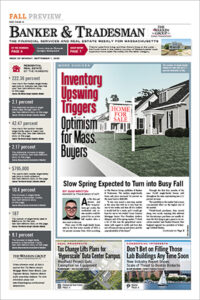
David A. Ball
Surveys overwhelmingly show that Massachusetts residents believe that we have a housing crisis and want more housing built – they just don’t want it built anywhere near them.
Local resistance to new housing of all kinds is not unique to Massachusetts, but is the greatest challenge that that we face in overcoming our housing crisis. While the rising cost of land and construction and high interest rates are also inhibitors, the permitting of new housing has simply never been more difficult.
Many worthwhile projects meet their demise at the hands of community activists and local officials who argue that burdens on schools and roads and changes to the community’s “fabric” – whatever that really means – should prevent anything from getting built.
The perfect is the enemy of the good. In this instance, it is sapping our commonwealth’s competitiveness, harming local businesses and discouraging young people from staying here.
A Place to Share Innovation
As someone who runs a communications firm, I am, perhaps, not the usual op-ed author in these finance and real-estate focused pages. The housing crisis, however, is, as much as anything a communications problem. We have lost the ability to engage in meaningful and productive dialogue around housing.
That is why our firm is embracing this immense challenge and creating what we are calling our HousingLab, to generate meaningful new ideas to help solve the crisis. Some ideas may create success and other may not – that is the importance of it being a lab. We are bringing housing clients together to innovate and advance new concepts.
Not every proposal for new housing is well-designed and appropriately scaled for its neighborhood, and those are legitimate instances where community feedback can be greatly beneficial. But in most cases, developers are willing to be flexible and to work with the community. At the end of the day, however, their projects must pencil out to ensure that financing terms can be met and that the project is economically worthwhile.
We want to fight the disinformation that makes so many valid housing proposals doomed from the start. Below are just a few examples of where we can make progress.
Starter Homes and Better Permitting
Builders in Massachusetts created tens of thousands of starter homes after World War II to house returning GIs and their growing families. The well-known Campanelli ranches – or “Campis” as they became to be known – were built by the hundreds in several Eastern Massachusetts communities. They were sited on quarter-acre lots and came in several models, with most a little over a thousand square feet. Young families moved in and some added on as space needs increased or eventually moved to larger homes.
These gave people a foothold (and a wealth-building tool) in the market that doesn’t exist today. Starter homes are seldom built any longer. Exclusionary zoning in some communities essentially prohibits them. A decades-old practice of lot merger has prevented many vacant lots from becoming buildable, and that can be fixed with a law change.
The way we evaluate new proposals is also broken. In most communities, a planning board or zoning board of appeals will ultimately seek to apply a zoning code created in the 1950s or1960s and require that a hardship be shown in order to approve a project. The housing crisis in and of itself should meet hardship criteria. In other words, projects that will add housing stock in the current highly constrained environment should get additional weight.
In our transit-oriented downtowns, which have been hard-hit by economic decline – in some cases pandemic-induced – housing should be allowed by right. If the density is too great or the design unappealing, those things can be altered. Currently, it feels like all or nothing – the permitting process doesn’t really allow for compromise.
Be Honest, Amplify What Works
When citizens groups are formed to block new housing developments, they often distort the reality of what is before officials or the voters. Scare tactics must be put to rest and actual facts embraced during discussions around proposals for new housing. An independent website – perhaps run by the state or by a university – that provides facts on major housing proposals could act as an honest broker in these debates.
Another important idea: Amplify what works. The Massachusetts Housing Development Incentive Program (HDIP) has assisted in the creation of thousands of units of housing where it is needed most, in our Gateway Cities, which are working to reverse decades of economic decline. New multifamily housing developments in these communities often don’t pencil out because the return on these projects doesn’t cover the costs. HDIP provides tax credits that bridge the funding gap and get units delivered.
A minimum investment from taxpayers generates maximum returns, enabling not only scores of new housing units, but buildings that help revitalize city centers – which will, in turn, lead to the creation of more housing. The state broadened its investment in HDIP last year, and that is an example of embracing what works.
Through our new focus on housing, we hope to shed light on the best ideas for creating abundant housing of all types. As the business community knows all too well, our economic viability depends on it.
David A. Ball is the president and founder of Ball Consulting Group, LLC, a strategic communications firm based in Newton.






